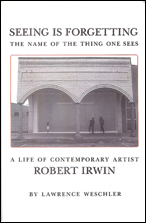 |
Lawrence Wechsler. Seeing Is Forgetting the Name of the Thing One Sees: A Life of Contemporary Artist Robert Irwin. Berkeley and Los Angeles: University of California Press, 1982.
By capturing a young, terse Robert Irwin of the nineteen-sixties, Lawrence Weschsler also captures a generation of Los Angeles artists and the environment that inspired them. Invariably, I always re-read this book, or parts of this book at least once a year, recently using it for research on an interview I conducted with Los Angeles artist Edgar Arcenaux. My favorite parts of the book are Wechsler’s descriptions of Irwin’s uniquely bizarre Minimalist installation/performances in the California desert. His secondhand documentation of Irwin’s work continues to relevantly describe the crucial impact of the Los Angeles desert on American art.
|